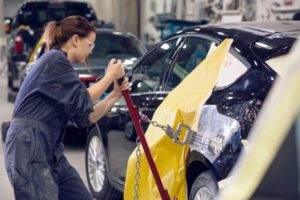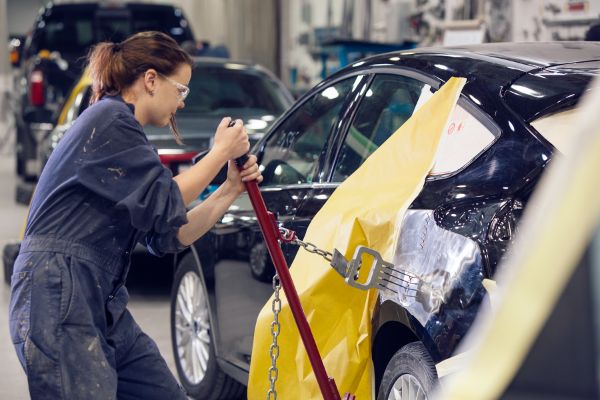Whether applying a shiny finish to add sparkle or repairing structural damage, Juanito’s Auto Body repairers return vehicles to near-new condition. They use a wide range of tools and techniques to restore damaged cars and trucks, including pneumatic and plasma cutters, paint sprayers, and hand tools.
Unlike mechanics, auto body repair shops don’t service mechanical systems like engine components, work on brakes, or do tune-ups. That’s why they specialize in collision repair and restoration services.
The frame of your car is essentially the skeleton on which everything else is built. That’s why it’s so important that this area is properly repaired after a collision. If not, it could throw off the alignment of your vehicle and even make it unsafe to drive.
The problem is that it can be difficult for the average person to see frame damage or know if there’s structural damage underneath the body paneling. This is why it’s essential to take your car to a shop with experience and computerized frame machines.
An auto body frame machine is a large platform with rotatable towers that clamp the frame of your car into place. It uses laser sensors to measure how far off the frame is from the factory specifications at several points on your car’s chassis. This allows the technician to determine if your vehicle can be straightened, needs a replacement part, or needs a completely new frame.
Aside from its obvious role in supporting the body and engine, the frame of your car is also home to important safety features like crumple zones. These zones are designed to absorb the kinetic energy of a collision by folding or crumpling, protecting passengers and lowering the number of fatalities in passenger vehicles. When the frame of your car is damaged, these crumple zones can no longer do their job. This can leave your car vulnerable to further damage and may even render it undriveable.
While it’s tempting to save money and keep a damaged car, this can be very dangerous for you and others on the road. It’s also against the law in many states. To ensure your safety and the safety of other drivers, always have any frame or structural damage repaired by a professional auto body shop.
Mechanical Repair
A good auto body shop will be able to handle mechanical repairs as well as paint work. They will be able to replace broken parts, such as the fender or bumper, and make sure the vehicle is aligned properly and is drivable. They will also be able to work with your insurance company to get the necessary mechanical parts.
This will usually include things like new drive belts or a transmission rebuild. Some of these repairs will take longer than others, so if you need to have your car back quickly, check the shop’s website to find out how long they typically take for each part of the job.
Once the auto body shop has an estimate from the insurance company and you’ve dropped off your vehicle for repairs, they will disassemble it to create a blueprint of the work they need to do. It’s possible that during this process, more damage will surface that they missed on their visual inspection. If this happens, the auto body technician will contact you and your insurance company right away and ask to adjust the repair estimates.
When the repair work is done, the auto body repair center will reassemble your vehicle and inspect it again for any minor glitches. They will also do a test drive to ensure everything is working as it should. Depending on where you live, an auto body repair company will often be able to coordinate rental vehicles for you while your car is in the shop for repairs. You should always get a written estimate from the auto body shop and compare it with quotes from other shops to be sure you’re getting the best value for your money.
It’s important to choose a reputable and trustworthy auto body shop. Read reviews and testimonials online to learn more about the customer experience at a particular shop. You may even want to call or visit the shop and speak with a representative to determine how they can help you in the future. It is not uncommon for an insurance company to recommend a specific auto body shop, but don’t feel obligated to follow their suggestions.
Painting
Painting is a complex process that requires the proper tools and environment. Paint must be applied and cured in a clean, dust-free area. Shops use sophisticated booths with advanced exhaust systems and heaters to ensure a smooth, professional job. The first step in the paint process is sandblasting, which removes imperfections, old paint, and rust from the vehicle surface to create a perfect, even base for the next coat.
A phosphate coat is then applied to protect against corrosion. Once the phosphate coat is dry, the bodywork is sanded again and then wiped down with thinner to get rid of any powdery residue. Then the primer is applied, and a couple of coats are needed to ensure the vehicle is covered evenly. After each coat is thoroughly dried, the vehicle is sanded again and wiped down with thinner.
The topcoat is then applied, which can be either a solid color or a metallic or pearlescent paint. Finally, a clear coat is added to protect the paint and give it a high shine. The paint is typically urethane, which lasts longer than acrylic lacquer paint. It’s also a good idea to wax your vehicle every 3–4 months to help maintain its finish.
Final Inspection
The inspections are performed outside during daylight conditions and inside the shop using fluorescent lighting and a good lift to inspect the underside of the vehicle. The car is then presented to the customer along with a detailed inspection report. In general, the inspector will verify that the repairs performed are as stated on the inspection report and that all components are in place. He or she will also look at the paint job to see that it is as close as possible to the original appearance of the vehicle.
This is the time to replace any damaged exterior panels. Once these are replaced, the refinishing process can begin in the paint preparation area. All body panels will be prepared for primer, and the final top color and clear coats will be applied. After the refinishing is complete, the body will be reassembled in the assembly area. The last of the moldings and detail pieces will be put on. Once all of the refinishing is complete, the final inspection can be completed.
Once the final inspection is complete, the car can be registered and issued a license plate. However, it is important to note that this does not mean the car is roadworthy. A multi-point inspection needs to be conducted by a certified technician in order for the car to pass. The inspection will include the verification of the vehicle’s registration information, a test drive, an inspection of lights and compulsory equipment, a superficial inspection of visibility and handling hindrances and bodywork, brake testing, and an underneath inspection for suspension parts, among others.
The inspection will be conducted by a qualified mechanic at an official certification center, and a certificate will be provided to the customer upon passing the inspection. It is advisable to bring a notebook or smartphone with you to your inspection appointment so that you can write down the numbers and details that are given to you.

